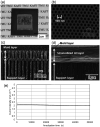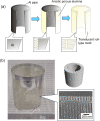Flat and roll-type translucent anodic porous alumina molds anodized in oxalic acid for UV nanoimprint lithography
- PMID: 37964907
- PMCID: PMC10641565
- DOI: 10.1039/d3ra06240f
Flat and roll-type translucent anodic porous alumina molds anodized in oxalic acid for UV nanoimprint lithography
Abstract
There is much interest in UV nanoimprinting as a fabrication method for various functional devices because of its suitability for efficient fine patterning. To form patterns on opaque substrates by UV nanoimprinting, it is essential to use molds through which UV light can pass. In this study, translucent anodic porous alumina (APA) molds for UV nanoimprinting were fabricated by the anodization of an Al substrate. To fabricate a translucent APA mold, an ordered APA film used as a mold for UV nanoimprinting was formed on the surface side of the Al substrate, and then anodization was continued from the back surface of the Al substrate to increase its transparency in the UV spectral range. A gradient change of Al thickness is necessary for the production of a large-area translucent mold, since it lowers the thickness of opaque defects remaining in the mold. The resulting translucent mold was effective for UV nanoimprinting to prepare ordered polymer nanopillar arrays on the surfaces of opaque substrates because the transmittance of the resulting translucent APA mold was 40% at a wavelength of 365 nm, which was confirmed to be sufficiently translucent to polymerize the photocurable monomer used in this study. In addition, it was possible to fabricate roll-type translucent APA molds by using Al pipes as a starting material. A seamless ordered nanopillar array can be effectively formed on a substrate by continuous UV nanoimprinting using the resulting roll-type translucent APA molds. Ordered nanopillar arrays formed on opaque substrates by UV nanoimprinting using translucent APA molds have various potential applications, such as those for forming antireflective and water-repellent surfaces.
This journal is © The Royal Society of Chemistry.
Conflict of interest statement
There are no conflicts to declare.
Figures







References
-
- Terris B. D. Mamin H. J. Best M. E. Logan J. A. Rugar D. Rishton S. A. Appl. Phys. Lett. 1996;69:4262–4264.
-
- Arbabi A. Horie Y. Ball A. J. Bagheri M. Faraon A. Nat. Commun. 2015;6:7069. - PubMed
-
- McClelland G. M. Hart M. W. Rettner C. T. Best M. E. Carter K. R. Terris B. D. Appl. Phys. Lett. 2002;81:1483–1485.
-
- Cattoni A. Ghenuche P. Haghiri-Gosnet A.-M. Decanini D. Chen J. Pelouard J.-L. Collin S. Nano Lett. 2011;11:3557–3563. - PubMed
-
- Truskett V. N. Watts M. P. C. Trends Biotechnol. 2006;24:312–317. - PubMed
LinkOut - more resources
Full Text Sources

